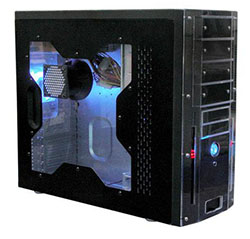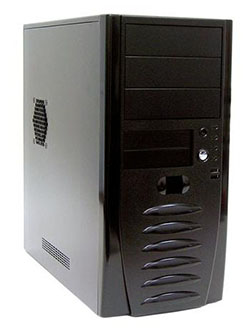Buyer's Guide - Entry Level to Mid-Range, March 2005
by Jarred Walton on March 15, 2005 1:30 PM EST- Posted in
- Guides
Case and Power Supply
Now that we have all the internal components picked out, it's time to find them a nice home. If you're not too choosy about the appearance of your computer, you can probably just head over to the local computer shop and pick up the cheapest case that you can find. Some may be more or less durable, but the vast majority of the steel cases on the market will manage to work just fine once everything is installed. You may cut a finger or scrape a knuckle if you're not careful with some of the cheap cases, but if you don't plan on upgrading often - or ever - such considerations don't matter a whole lot. Buy what you like, whether that's a boring case or something with 60s era sci-fi theme. More important than the case, however, will be the choice of power supply.Many of the sub-$50 cases that include a power supply could potentially have stability problems, so for peace of mind, we would strongly encourage you to pick up a better PSU for your system. You can always keep the original generic PSU around as a backup in case you have problems. If you're going to get a motherboard with PCI Express support, you will probably want to look at separate power supplies with the new 24-pin power adapter. As far as quality goes, Enermax and Antec continue to be the most recognized brands. They are also priced such that getting them into a budget system may be difficult unless you purchase a case with an included power supply. That would be our recommendation, with the Antec SLK1650 continuing to offer decent looks and performance for a reasonable price. But some people like to see what else is out there, so we've searched around to come up with some new options.
Case Recommendation: Rosewill ATX with 400W PSU, model TU-155
Price: $59 shipped
Rosewill is a newer brand on the market, but they've really manage to impress a lot of people looking for good values. Their cases have managed to catch our eye, and while we might question the reliability of the PSU, $61 for a case with a window as well as front USB and firewire ports is pretty impressive, and the PSU is pretty much gravy. You can find similarly priced offerings from Apex, Aspire, Codegen, In Win, Logisys and RAIDMAX, among others, but we like the overall look of the TU-155 as something different from the "boring" cases.
Case Alternative: Antec SLK1650B with 350W PSU
Price: $65 shipped
As we've so often pointed out, once you factor in the cost of shipping and a reasonable power supply, it's difficult to beat the Antec cases, particularly the low-end SLK16xx models. They are good, cheap cases with a reasonable quality PSU along with a single 120 mm temperature controlled rear fan. The one flaw is that the PSU is a standard ATX model, so adapters would be necessary if you want the full 24-pin power supplied to the motherboard. It is not strictly required to have a 24-pin power connector, of course, and when paired up with a relatively low-power PCIe card like the 6200TC, you should be fine. Down the road, however, it may become necessary to upgrade the PSU. With shipping adding almost $20 to the cost, however, it does hurt our overall budget. If you're willing to take the risk of a cheaper power supply, you can easily find cases at a local shop for under $50.
PSU Alternative: Enermax Noisetaker 370W, model EG375P-VE-SFMA
Price: $51 shipped
We've mentioned the quality of Enermax power supplies many times in the past. For this Guide, we felt it was important to make sure that the alternative PSU included a 24-pin power connector. [Unfortunately, we got bad information from Enermax's web site - this is not a 24-pin PSU! See note below.] While there are 20-to-24-pin adapters available, they are not guaranteed to work with upgraded video cards. 370W may seem on the low end of the scale, but remember that this is a quality 370 Watts, and it will certainly outperform most 400W to 450W competitors. The Noisetaker line is also one of the quieter power supply options out there, although it certainly isn't silent. For $50, though, you can't complain too much. As always, you can look at Antec, Fotron Source, PC Power and Cooling, Tagan, and ThermalTake as generally good quality options, if you want something other than the Enermax that we've suggested.
Updated Information: Have you ever had difficulty tracking down a reasonable choice for a component, based on a specific price range? If so, then you've probably built quite a few PCs, or perhaps written a guide such as this. Trust me, I searched for quite a while trying to find a reasonable 24-pin PSU for this Guide. I figured that if I'm going to recommend an alternate PSU, then it ought to have some longevity. Sure, $100+ Antec, Enermax, OCZ, etc. PSUs will provide you with everything you might need, as well as a 3 to 5 year warranty in many instances. However, $100 is a lot of money for a power supply, even in the mid-range sector.
The Enermax pages have images showing 24-pin compatibility on their web site for the above 370W PSU. While we still feel it's a very good PSU and it does include dual 12V rails, it does not have a 24-pin connector. The most reasonably priced PSU that we could find with a 24-pin connector is the A+ GPB/Athena Power 500W, model AP-P4ATX50F12. It costs around $60 shipped and appears to be a good quality PSU, but we're not sure about noise levels. Most other 24-pin PSUs cost substantially more, unfortunately. If you have any better suggestions for this price range, drop me a line. Thanks, and sorry for the confusion!













59 Comments
View All Comments
LoneWolf15 - Wednesday, March 16, 2005 - link
Note on the Hitachi hard disk drives:Hitachi is the ONLY major company that does not allow advance-exchange RMA of their hard disks. To me, this is huge when looking at a hard disk. Western Digital, Seagate, and Maxtor all have advanced exchange. After the nightmares I have had with IBM and Hitachi technical support, I could not in all honesty recommend them in a system. Personally, I can't afford that kind of downtime, having an advance replacement makes it easier to try and recover data from a crashed drive if necessary, and you aren't waiting in limbo while someone receives your defective drive, checks it in, diagnoses it bad, then sends you out a replacement, also placing you at the mercy of their stock-on-hand or whomever they choose to ship to you the replacement drive.
neologan - Wednesday, March 16, 2005 - link
There's another buyers guide at http://www.pureoverclock.com/review.php?id=9 but it doesn't choose its recommedations due to a really strict budget. Worth a read though i guess.JarredWalton - Wednesday, March 16, 2005 - link
26 - Thanks. Identity crisis indeed! I was originally looking at upgraded S754 instead of S939, but decided against it. :)As a side note, RAM prices have suddenly taken a massive cut. The PDP 2-3-2-5 is now $20 less than last week, and it's about $50 less than a couple months ago. Heck, you can even get 1GB (2x512) of Corsair CL2.5 for under $100 now - again, $50 less than last Guide!
chrisd154 - Wednesday, March 16, 2005 - link
"Socket 754 Alternative Motherboard: Chaintech VNF4 Socket 939""Socket 754 CPU: AMD Athlon 64 1.8 GHz 512KB L2 90nm socket 939"
Your socket 754 motherboard and cpu are having a bit of an identity crisis (i.e theyre 939). You might want to correct that mate.
JarredWalton - Wednesday, March 16, 2005 - link
24 - you want benchmarks of the speakers? Sorry, that's *way* beyond the scope of this Guide. Speakers costing $60 or less aren't being purchased primarily for their quality; they're being selected for price.If you mean benchmarks in general, that's something that would be great to have but not practical to do. Our various hardware reviews are meant to address the theory of what makes a good component/computer. For many of the parts in a budget system, price is a bigger factor than the final performance or quality. Sure, we'd like to have both, but the truth is you're not going to get SLI in a budget system. We do not have all of the parts available in one location for testing, and some of the parts may not even be in AnandTech's possession [anymore]. This is especially true of entry-level Guides, as many of the parts were new a year or more in the past
If you'd like specific information or you have a specific question, feel free to email me.
crimson117 - Wednesday, March 16, 2005 - link
I'd appreciate if you could add some benchmarks to compare "beeps and boops" quality. This guide is pretty much worthless without them.JarredWalton - Wednesday, March 16, 2005 - link
The MSI uATX is the only ATI Xpress 200 board currently available, and it's basically the same price as the Chaintech. Given that it's still pretty new, I'm a little hesitant to go with that over the "proven" nF4. Oh, and there are *no* overclocking options on the MSI board right now. Is that a BIOS problem or a chipset problem? I don't know. If you really like ATI or if you want a uATX form factor, it's definitely an option.kmmatney - Tuesday, March 15, 2005 - link
I'd consider the MSI ATI Radeon XPRESS 200 motherboard board for a budget system as well. From reviews I've read, using the on-board video doesn't seem to degrade overall 2D performance.Pair it with an Athlon 64 3000+ winchester for $235. A decent system for the non or light gamer, and you have the option of upgrading the video later. Too bad there aren't any budget 939 cpus.
JarredWalton - Tuesday, March 15, 2005 - link
I haven't had issues with the Chaintech, but that's only one person's experience with a specific RAM/GPU setup. The documentation is pretty lacking, but other than that it works well. Are you speaking from personal experience, and if so, what was the exact configuration (RAM, CPU, PSU, etc.)? It works well in the following configuration, although I had to manually set the RAM timings:Athlon64 3500+
Chaintech nForce4 VNF4
ATI X800 XL 256MB PCIe
1GB (2x512) Corsair DDR400 CAS2.5
Antec True430 PSU
NEC ND-3520A DVD±RW
WD 200GB SATA
SB Audigy 2 ZS
As for the DVD+RW, why save $20 when there won't be anything faster than a 16X burner, and the ability to backup 4.5GB of data rather than 700MB can come in handy? (And if that sounds like too much data, consider that a lot of people take digital pictures these days. A few hundred high quality images will fill a CD.) I mentioned the possibility to downgrade the optical drive, but I'm not going to recommend it.
mostlyprudent - Tuesday, March 15, 2005 - link
Are you serious ... recommending a motherboard with compatability and stability problems just to save $10? And why put a DVD-RW drive in a budget system? Optical drives are quite simple to upgrade down the road. You would have to be crazy to skimp on the quality of the motherboard to fit in an upgraded optical drive. You can get a DVD-ROM/CD-RW combo drive for about $20 less than the NEC drive you suggest. I would take that $20 dollars and invest it in a stable/reliable motherboard -- there is nothing worse than a finiky mobo as far as I'm concerned.